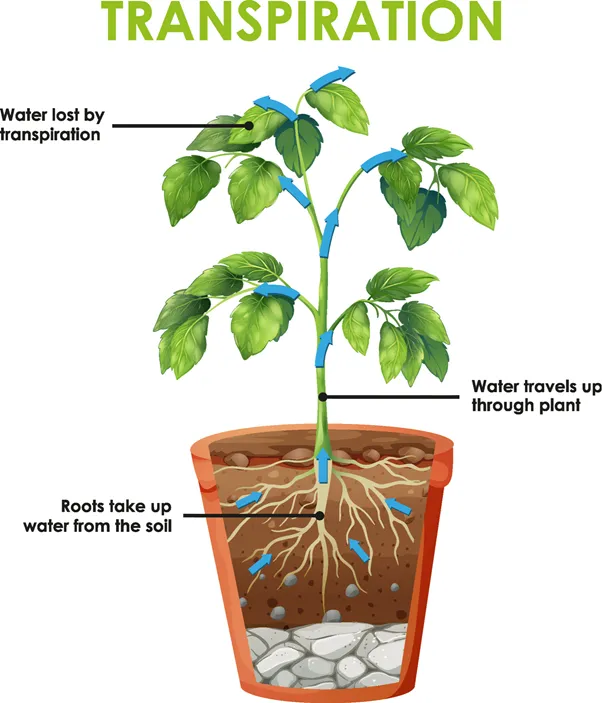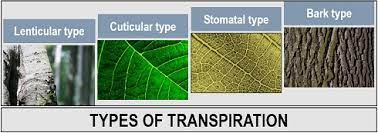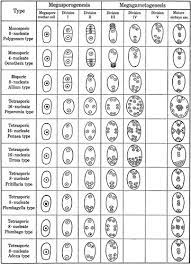TRANSPIRATION- definition, types, factors affecting transpiration
TRANSPIRATION
Definition:
The loss of excess of water in the form of vapour from various aerial parts of the plant is called transpiration.
Types of
Transpiration
Transpiration
is of following three types:
1. Stomatal
transpiration
Stomata are
microscopic structures present in high number on the lower epidermis of leaves.
This is the most dominant form of transpiration and being responsible for most
of the water loss (90 - 95%) in plants.
2.
Lenticular transpiration
In stems of
woody plants and trees, the epidermis is replaced by periderm because of
secondary growth. In order to provide gaseous exchange between the living cells
and outer atmosphere, some pores which looks like lens-shaped raised spots are present
on the surface of the stem called Lenticels. The loss of water from lenticels is
very insignificant as it amounts to only 0.1% of the total.
3.
Cuticular transpiration
The cuticle is a waxy or resinous layer of cutin, a fatty substance covering the epidermis of leaves and other plant parts. Loss of water through cuticle is relatively small and it is only about 5 to 10 % of the total transpiration. The thickness of cuticle increases in xerophytes and transpiration is very much reduced or totally absent.
Factors
Affecting Rate of Transpiration:
The factors
affecting the rate of transpiration can be categorized into two groups. They
are
1. External
or Environmental factors
2. Internal
or plant factors.
1. External
or Environmental factors
i. Atmospheric humidity:
The rate of transpiration is greatly reduced when the
atmosphere is very humid. As the air becomes dry, the rate of transpiration is also
increased proportionately.
ii. Temperature:
With the increase in atmospheric temperature, the rate of transpiration
also increases. However, at very high-temperatures stomata closes because of
flaccidity and transpiration stop.
iii. Light:
Light intensity increases the temperature. As in temperature, transpiration is
increased in high light intensity and is decreased in low light intensity.
Light also increases the permeability of the cell membrane, making it easy for
water molecules to move out of the cell.
iv. Wind velocity:
In still air, the surface above the stomata get saturated with water
vapours and there is no need for more water vapour to come out. If the wind is
breezy, water vapour gets carried away near leaf surface and DPD is created to
draw more vapour from the leaf cells enhancing transpiration. However, high
wind velocity creates an extreme increase in water loss and leads to a reduced
rate of transpiration and stomata remain closed.
v. Atmospheric pressure:
In low atmospheric pressure, the rate of transpiration
increases. Hills favour high transpiration rate due to low atmospheric pressure.
However, it is neutralized by low temperature prevailing in the hills.
vi. Water:
Adequate amount of water in the soil is a pre-requisite for optimum plant growth.
Excessive loss of water through transpiration leads to wilting. In general, there
are three types of wilting as follows,
a.
Incipient wilting: Water content of plant cell decreases but the symptoms are not
visible.
b.
Temporary wilting: On hot summer days, the freshness of herbaceous plants reduces
turgor pressure at the day time and regains it at night.
c. Permanent wilting: The absorption of water virtually ceases because the plant cell does not get water from any source and the plant cell passes into a state of permanent wilting.
2. Internal
factors
Leaf area:
If the leaf area is more, transpiration is faster and so xerophytes reduce their leaf size.
Leaf
structure:
Some anatomical features of leaves like sunken stomata, the presence of hairs, cuticle, the presence of hydrophilic substances like gum, mucilage help to reduce the rate of transpiration. In xerophytes the structural modifications are remarkable. To avoid transpiration, as in Opuntia the stem is flattened to look like leaves called Phylloclade. Cladode or cladophyll in Asparagus is a modified stem capable of limited growth looking like leaves. In some plants, the petioles are flattened and widened, to become phyllodes example Acacia melanoxylon.








Comments